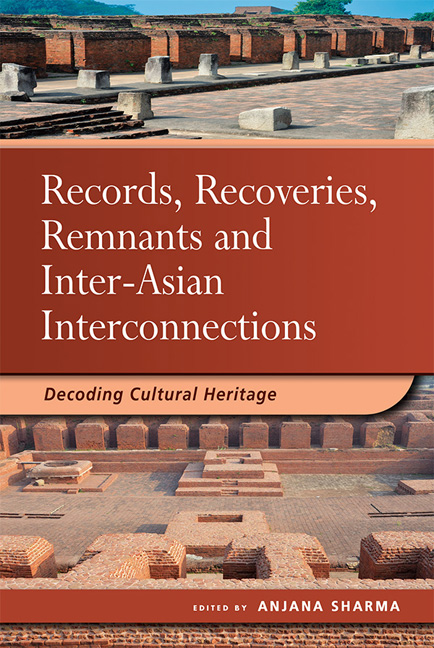Book contents
- Frontmatter
- Dedication
- Contents
- Contributors
- Acknowledgements
- 1 Introduction: Records, Recoveries, Remnants and Inter-Asian Interconnections — Decoding Cultural Heritage
- 2 Negotiating Place and Heritage: Creating Nalanda University
- 3 India, Magadha, Nalanda: Ecology and a Premodern World System
- 4 Collecting the Region: Configuring Bihar in the Space of Museums
- 5 Heritage Preservation in the Gaya Region
- 6 Setting the “Records” Straight: Textual Sources on Nālandā and Their Historical Value
- 7 “Central India Is What Is Called the Middle Kingdom”
- 8 The Object | The Tree: Emissaries of Buddhist Ground
- 9 Tracing Transregional Networks and Connections Across the Indic Manuscript Cultures of Nusantara (AD 1400–1600)
- 10 Seeking a Sufi Heritage in the Deccan
- 11 Archaeological Remains at Nalanda: A Spatial Comparison of Nineteenth Century Observations and the Protected World Heritage Site
- 12 A Heritage Gem Sits in the Heart of a City, Unacknowledged, Incognito: The Case for Recognizing Kolkata Chinatown as a Historic Urban Landscape
- Index
- Miscellaneous Endmatter
10 - Seeking a Sufi Heritage in the Deccan
Published online by Cambridge University Press: 04 July 2018
- Frontmatter
- Dedication
- Contents
- Contributors
- Acknowledgements
- 1 Introduction: Records, Recoveries, Remnants and Inter-Asian Interconnections — Decoding Cultural Heritage
- 2 Negotiating Place and Heritage: Creating Nalanda University
- 3 India, Magadha, Nalanda: Ecology and a Premodern World System
- 4 Collecting the Region: Configuring Bihar in the Space of Museums
- 5 Heritage Preservation in the Gaya Region
- 6 Setting the “Records” Straight: Textual Sources on Nālandā and Their Historical Value
- 7 “Central India Is What Is Called the Middle Kingdom”
- 8 The Object | The Tree: Emissaries of Buddhist Ground
- 9 Tracing Transregional Networks and Connections Across the Indic Manuscript Cultures of Nusantara (AD 1400–1600)
- 10 Seeking a Sufi Heritage in the Deccan
- 11 Archaeological Remains at Nalanda: A Spatial Comparison of Nineteenth Century Observations and the Protected World Heritage Site
- 12 A Heritage Gem Sits in the Heart of a City, Unacknowledged, Incognito: The Case for Recognizing Kolkata Chinatown as a Historic Urban Landscape
- Index
- Miscellaneous Endmatter
Summary
In the multi-volume work The Heritage of Sufism covering an entire millennium of Persianate Sufism, Leonard Lewisohn recognizes the difficulty of undertaking a “comprehensive coverage of all the mystical contexts” that characterize Sufi heritage within the span of a single study. Covering the expansive idea of a “spiritual and cultural renaissance” in Persian society between 1200 and 1500 the work identifies Sufism as a major catalyst for these developments. The religious climate of Persia in the aforementioned period was intensely influenced by Sufi traditions led by masters like Jalaluddin Rumi (d. 1273), Nimatullah Wali (d. 1431), Hafez Shirazi (d. 1389), Saadi (d. 1292), and Saiyid Ali Hamadani (d. 1384) among many others. Their works and activities shaped pre-Safavid Persia in a manner which scholars have characterized as a “renaissance” — in literature, arts, Islamic sciences, philosophy, music and mystical scholarship. One can grasp Lewisohn's emphasis on the impossibility of covering comprehensively all dimensions of this Sufi tradition between the covers of a single volume. Certain important aspects remain unexplored, even though they are critical towards understanding the heritage of Persian Sufism.
In an interesting parallel, South Asia presents before us similar difficulties of undertaking a comprehensive study of a Sufi heritage in this region. Within the same time frame, before the rise of the Mughal Empire — the South Asian equivalent of the mighty Safavids — Sufi activities spread across north India, and also the South, particularly the Deccan region. This paper will look into certain aspects connected to the rise of Sufi networks in the Deccan in the thirteenth and fourteenth centuries, at a time when Deccan's Sanskritized cultural world experienced the coming of a north Indian Persian tradition. In spite of some obvious similarities with the Iranian situation, the focus will be less on such sweeping categories as “renaissance”. Rather the article will seek to engage with a different set of questions more relevant to the idea of a Sufi heritage.
What roles did Sufi saints and, later, their shrines play in creating a heritage? Was this idea sustained only through tangible traces of their shrines? Or can it be located in the intangible idea of mystical rituals and practices, like sama? How did the chain of spiritual succession ensure the continuity of this heritage?
- Type
- Chapter
- Information
- Records, Recoveries, Remnants and Inter-Asian InterconnectionsDecoding Cultural Heritage, pp. 222 - 238Publisher: ISEAS–Yusof Ishak InstitutePrint publication year: 2018



